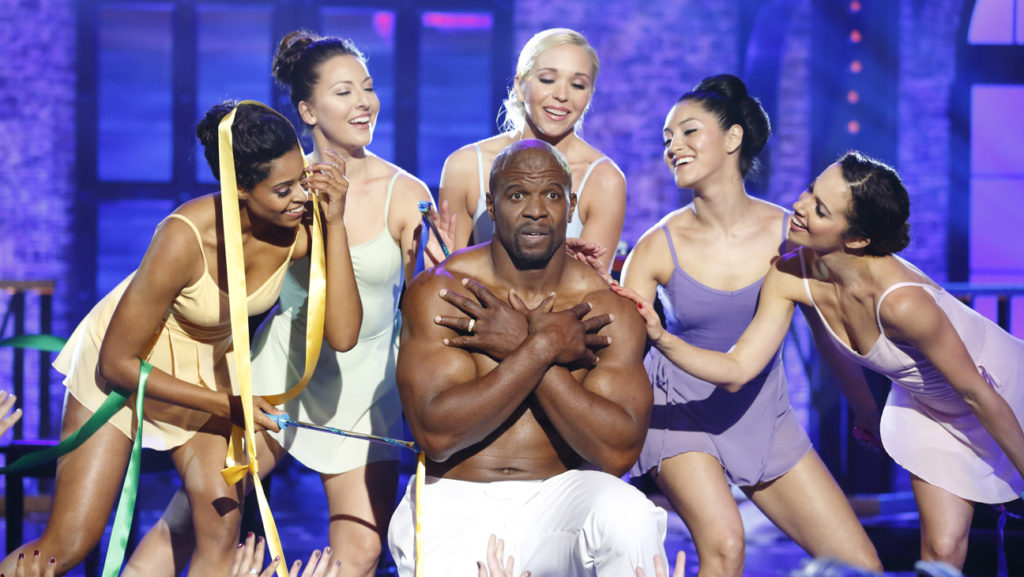Miniskirts and Wigs: The Gender Politics of Cross-Dressing on Lip Sync Battle
Britta Hanson / University of Texas at Austin
On January 7, 2016, Channing Tatum blew up the internet. He strutted onto Lip Sync Battle’s stage wearing a voluminous blonde wig and a tight black mini-skirt to faux-sing “Run the World (Girls),” with Beyoncé herself joining in at the number’s end. The performance became a viral sensation, and the episode itself an all-time ratings high for Spike.1 This overwhelming popularity was not because of the excellence of Tatum’s dancing, but because of its gender-bending presentation.
Tatum’s performance is only one of many times that Lip Sync Battle has blurred traditional gender roles; in fact, the majority of LSB’s episodes contain some form of gender-bending, and the performers who do so almost always win. Judith Butler taught us years ago that gender is inherently performative, and that drag in its many forms has a powerful subversive potential.2 Yet LSB presents an intriguing paradox: while it hosts a plethora of non-normative performances, the show ultimately reifies gender binaries, and places its stars squarely back in their “original” gender.3
The show’s structure is simple. Two stars (usually of TV-based fame, but sometimes musicians or film actors) lip sync to two songs each, with the winner decided by the in-studio audience’s applause. Because the music is always a prerecorded, familiar pop hit, the star’s responsibilities are limited to mouthing the words and, more importantly, presenting the most outlandish physical display possible.
The measure of this outlandishness is directly related to the subversion of the star’s image. The sweet, demure Anne Hathaway won her battle by clamoring onto a life-size wrecking ball in her underwear to perform Miley Cyrus’ “Wrecking Ball.” Cross-dressing is treated as another method of going all the way for the competition. Justin Bieber, after performing Fergie’s “Big Girls Don’t Cry” while affecting femininity, including comically swaying his hips and even stroking competitor Deion Sanders’ chin, explained afterward that “I just totally committed! Full commitment.” Occasionally stars embrace the subversive nature of their performance: former NFL player Terry Crews, after dancing to Vanessa Carlton’s “A Thousand Miles” half-naked accompanied by baton twirlers, said he found inspiration in his wife and four daughters: “sometimes you just need to access your feminine side,” he exclaimed to wild cheers from the audience.
But LSB as a whole does not foster such open-mindedness: instead, the program carefully positions its performances as temporary aberrances in the stars’ lives. Stars must constantly reestablish their personas, as Richard Dyer explains, and LSB allows them to act out who they are, or are not.4 So while the most popular performances involve macho men – professional athletes, rappers, action movie stars – wearing dresses and wigs, the show works hard to show that the stars’ costume and dance choices have no bearing on their “real life,” which means demonstrating that the stars are irrefutably heterosexual and cis-gendered.
LSB employs several strategies to corroborate its stars’ straightness. Most simply, host LL Cool J will ask the star to discuss how unusual this was for them, such as when comedian Gabriel Iglesias told Cool J that dressing as Donna Summer required him to shave for the first time in five years. Other times, the spouse of the performer also appears on the show, with their shocked reaction to their partner’s gender-bent performance serving as an external guarantee of heteronormativity.5 Throughout, Cool J and color commentator Chrissy Teigen model the acceptable reaction to these antics. Cool J, a rapper, is often quietly disapproving, while Teigen, a model, spends most of her time evaluating how sexy (or more often unsexy) the performers are in their adopted garb.6 These strategies taken together are meant to signal that these performances cannot possibly be taken seriously.7
When a performance breaks these careful restrictions, the show is thrown into chaos. One of LSB’s lowest-rated episodes featured three total gender-bent performances by competitors Jim Rash and Joe McHale. The most notable of these was Rash’s self-described “seduction” of McHale to En Vogue’s “Something He Can Feel,” during which he straddled McHale’s chair and proceeded to caress and shimmy all around him, while McHale grimaced horribly. Despite his scowling, McHale commented afterward that “someone is going to need to wipe off” his seat, and that this sort of thing happens “all the time” on Community, the show both men act in. Cool J and Teigen seemed flabbergasted. Teigen asked Rash if he had ever done “all of that” before, to which Rash replied, “don’t worry about it.” In this way, Rash, who has refused to comment publicly on his sexuality, indirectly linked himself to homoerotic practices in his own life, and McHale, who is heterosexual, indicated that his active participation not only in their on-stage interaction, but in similar events in their professional lives. Thus both performers actively embraced a subversive gender position, although McHale, after his own performance in drag, acknowledged that their actions were outside the norm: “thank you for letting me shorten my career in front of you,” he shouted to the audience.

What then, is the ultimate effect of all this gender confusion? For the stars, very little. As long as they carefully delineate their performance from their star persona, this exercise merely signals to casting directors that the star is capable of playing many (gender) roles outside of their normal type. The most immediate benefit is to the network. LSB airs on Spike, a channel which has recently attempted to expand viewership from an exclusively macho-male demographic to one that includes female viewers and attracts co-viewing as well.8 Network president Kevin Kay commented that LSB was picked up because “it felt like the perfect show to help launch that rebrand.”9 For the network, too, LSB is meant to be a step outside of its box, but not a complete leap.
David Greven argues that our “new queerly-inflected mainstream movie practices” have the potential to open up “safe zones of polyvalent pleasures.”10 This is far too utopic a vision to extend to Lip Sync Battle. There is certainly potential for breaking the strict boundary between male and female in the show’s constant cross-dressing. But as we have seen, the show shuts down any subversive possibility as effectively as Tatum wore his wig.
Image Credits:
1. Promotional image for Spike’s Lip Sync Battle, Season 2, Episode 1, originally aired January 7, 2016.
2. Author’s screen grab from Spike’s Lip Sync Battle, Season 2, Episode 5, originally aired April 23, 2015.
3. Author’s screen grab from Spike’s Lip Sync Battle, Season 2, Episode 13, originally aired April 28, 2016.
4. Promotional image from Spike’s Lip Sync Battle, Season 2, Episode 13, originally aired April 28, 2016.
Please feel free to comment.
- Rick Kissell, “‘Lip Sync Battle’ Sets Spike Network Ratings Record,” Variety, January 12, 2016, http://variety.com/2016/tv/news/lip-sync-battle-sets-spike-ratings-record-1201678032/ [↩]
- See Judith Butler, Gender Trouble (New York: Routledge, 1990). Granted, Lip Sync Battle does not embrace drag culture, only allowing cross-dressing in a comical way, but I argue that even the mild form of cross-dressing LSB hosts is still potentially subversive. [↩]
- Notably, the show’s attitude mirrors what Chris Straayer identifies as the “temporary transvestite” genre, which depicts constant transgression while constantly reminding the audience of the character’s “original” gender. See Chris Straayer, Deviant Eyes, Deviant Bodies: Sexual Re-Orientation in Film and Video (New York: Columbia University Press, 1996), 46-50. [↩]
- See Richard Dyer, Stars (London: BFI, 1979), 20. [↩]
- For example, when Iggy Azalea performed Silk’s “Freak Me,” complete with grabbing her crotch and miming sexual intercourse, her then-fiancé Nick Young stated adamantly that “She don’t do that…she don’t do that to me!” [↩]
- And that garb itself is often intentionally ridiculous, with Deion Sanders’ wig for “Like a Virgin” more closely resembling Einstein than Madonna. The few occasions when such costumes are not ridiculous, as in Jim Rash’s form-fitting P!nk costume, often leave the hosts unsure how to react. [↩]
- While the length of this piece restricts me from discussing male versus female cross-dressers in detail, female cross-dressers on LSB often work even harder than the men to reestablish their gender identity, with their second, non-drag number usually being hyper-feminine: see Jenna Dewan-Tatum’s “Pony” and “Cold-Hearted” or Kaley Cuoco’s “Move Bitch” and “I’m a Slave 4 U.” [↩]
- See the original description of their brand when the channel relaunched under that name in 2003: “TNN network can call itself Spike TV,” USA Today, July 7, 2003, http://usatoday30.usatoday.com/life/television/2003-07-07-spike_x.htm [↩]
- L.A. Ross, How Jimmy Fallon’s ‘Lip Sync Battle’ Launched SpikeTV’s Rebrand: ‘Right Swing at Right Moment’, TheWrap.com, April 16, 2015,
http://www.thewrap.com/how-jimmy-fallons-lip-sync-battle-launched-spiketvs-rebrand-right-swing-at-right-moment/ [↩] - David Greven, Manhood in Hollywood from Bush to Bush (Austin: University of Texas Press, 2009), 17. [↩]



This is so funny! and nice site!
I watch that everytime. And I laugh this everytime.
This is incredible. Thanks!
Amazing website.
Pingback: Miniskirts and Wigs: The Gender Politics of Cross-Dressing on Lip Sync Battle – Introduction to Electronic Media and Film
that is very funny well done
hahah good humor very funny.
This is so funny! good content
what a funny news :D